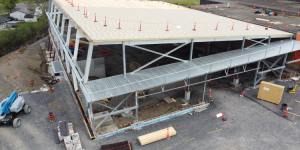The owners were negligent in failing to adequately investigate the properties of building materials that were specified and, most importantly, by failing to make the contractor aware of critical information. The owners and the contractor were therefore 50 per cent contributorily negligent, and had to bear equal responsibility for the damages.
Condo Owner And Contractor Equally Responsible For Breach Of Contract And Damages
by Paul Sandori
Intrawest Corporation and The Owners, Strata Plan No. N83 v. Hart
Condo owners contracted to replace leaking cedar shake roofs with glass laminate shingles • contractor not given relevant information regarding ventilation problem which had caused leakage • contractor did not inquire as to roof construction • contractor discovered problem and recommended remedial work at additional expense • owner refused • subsequent extensive leakage • owner and contractor equally responsible for warranty, breach of contract and damages • owner awarded one-half of contract price and subsequent repair expenditure
In 1996, the condominiums of Strata Plan No. N83 were experiencing problems with leaking roofs. In 1997, Intrawest Corporation, the manager of the condominiums, obtained a technical report which blamed ice damming as the cause of most of the leakage. Ice damming was primarily caused by the lack of ventilation space above the insulation in the roof which had vaulted ceilings underneath and no attic.
The condominium Owners decided to replace the roofing as this would soon be required due to normal wear and tear in any event. Intrawest suggested glass laminate shingles as a replacement for the existing cedar shakes. Neither the Owners nor Intrawest obtained any advice as to the appropriateness of that type of roofing for the specific application intended.
A roofing contractor, Assured Roofing, provided a quotation in the amount of $262,293 for the re-roofing, including a two-year labour guarantee and a 25-year material warranty. Assured also agreed that it will “…ensure that there's adequate ventilation. If found to be [in]adequate then Assured Roofing will correct it to code”.
Surprisingly, no one informed Assured of the ice damming problem nor provided a list of the condominium units affected by leaks. Equally surprising, the principal of Assured, Mr. Hart, made no inquiry as to the roof construction. He assumed that the buildings had attics. Hart also assumed that ice damming, if any, would be only a few inches thick. In fact, in some areas, it was several feet thick.
Assured’s quote was accepted. When the roofers opened up parts of the roofs, they discovered that there was a vaulted ceiling, that insulation was over-stuffed in parts, and missing in others. They also discovered the lack of ventilation.
Hart very strongly recommended to the Owners that they remove all of the plywood sheathing to ensure that the roof could “breathe better". The cost of all this extra work, however, would have increased the price of the roofing contract by at least 50 per cent. The Owners refused. At trial, Intrawest testified that Assured had said that, even without the proposed remedial work, the roof would still be watertight. In the end, Assured replaced all the roofs without correcting the ventilation problem. The following winter, water backed up underneath the shingles and causing extensive damage to numerous condominium units.
Water penetration was in part due to the flashings at the edges of the roofs. In order for Assured to replace these flashings, the stucco would have to be partially removed from the walls. The Owners refused to absorb the extra expense. Assured left the old flashings in place and attempted a makeshift remedy to eliminate the gap. It did not work. At trial, the Owners said that, if they had been told that the proposed solution would not work as well as installing new flashings, they would not have agreed to it.
The leakage caused considerable damage and expense. The Owners sued Assured alleging breach of contract, breach of an implied warranty contained in the contract, and negligence in carrying out the work.
Liability in Contract
The trial judge, Justice Melnick, found that Assured did not fulfil its contract with the Owners.
Assured was to supply and install new metal flashings; instead, it left the old flashings in place. However, the judge found that there was a verbal variation of the terms of the contract as a result of the decision of the Owners to save money by reusing the old flashings. Resulting problems could not be blamed on Assured.
Assured contracted to ensure adequate ventilation of the roofs, and was therefore in breach of this term of the contract. The Owners decided not to proceed with the ventilation work in the belief that, however necessary it was to do the remedial work, they would nevertheless have watertight roofs. On the other hand, the assurance they got from Assured was the result of their withholding from Assured critical information about ice damming. Thus, said Justice Melnick, the Owners contributed in a real and measurable way to Assured’s breach of contract. They were therefore equally responsible.
Promissory Estoppel
Could Assured rely on the doctrine of promissory estoppel to estop the Owners from relying on the contract? Promissory estoppel is a well-developed doctrine in Canada. In Maracle v. Travellers Indemnity Co. of Canada, Justice Sopinka of the Supreme Court of Canada summarized this doctrine:
The principles of promissory estoppel are well settled. The party relying on the doctrine must establish that the other party has, by words or conduct, made a promise or assurance which was intended to affect their legal relationship and to be acted on. Furthermore, the representee must establish that, in reliance on the representation, he acted on it or in some way changed his position.
Justice Melnick considered the circumstances of the case:
· the silence of Intrawest and the Owners predated the contracts;
· the Owners did not deliberately withhold information in order to misrepresent the condition of the roofs;
· Assured removed part of the roof and saw for itself the nature of the roof’s construction and lack of ventilation;
· Assured thought the remedial work was important, yet it continued to do the work and assert that the roofs would not leak.
He concluded that estoppel could not protect the roofer from the Owners’ claim for breach of contract and warranty.
Offset
The court also considered whether the contribution of the Owners to the breach of contract could, to the extent of that contribution, offset the liability of Assured. Justice Melnick said:
I find that this is one of those cases where, there having been a duty of care imposed on Assured by the contracts, fairness dictates that [Intrawest and the Owners] not be entitled to full recovery of their damages in contract because of their contributory negligence in failing to advise Assured… of the extent of the ice damming problem….
He found that the Owners were equally liable for any damages in contract for which Assured might be liable.
Fitness for Purpose
The court found that the Owners’ choice of glass laminate shingles was an unfortunate one: they offered less resistance to heat flow than the wood shakes they replaced, and so aggravated the ice damming. They were not deficient but simply inappropriate for use on top of vaulted ceilings with inadequate ventilation and insulation. Thus, the leakage was not a matter that would fall under the specific 25-year material warranty set out in the contracts. Neither was there any evidence that the roofing materials were improperly installed.
However, the Owners maintained that their contracts with Assured contained an implied warranty that the new roofing would be fit for its intended purpose, namely to provide a watertight cover for the buildings underneath. Justice Melnick agreed and found Assured in breach of an implied warranty of fitness. However, once again he found that the Owners bore equal responsibility with Assured for bringing about the breach of warranty.
Negligence
Justice Melnick held that Assured was negligent in its performance of its contract duties owed to the Owners. It failed to make adequate inquiries as to the nature of the construction of the buildings, to provide adequate ventilation, and to check the properties of the glass laminate shingles specified by the Owners.
On the other hand, the Owners were also negligent in failing to adequately investigate the properties of the glass laminate shingles that were specified and, most importantly, by failing to make Assured aware of critical information. The Owners and Intrawest were therefore 50 per cent contributorily negligent, and had to bear equal responsibility for the damages.
The failure of Assured to install new flashing was not negligent. Assured wanted to install new flashing, and would have done so if the Owners had agreed. “The Owners and Intrawest agreed that the scope of the work be changed with respect to the flashing and they must live with the consequences”, concluded the trial judge.
Damages
The appropriate measure of damages was found to be the original cost of construction, plus any additional costs resulting from the subsequent leakage.
The contract price totalled $262,293. In addition, the Owners claimed a total expenditure of $59,608 for the repairs. The court allowed damages of only $42,400 because the supporting documentation did not make it clear that all the repairs necessarily resulted from the leakage. The Owners also claimed $37,343 for remedial repairs to the flashings. The court rejected that claim.
The total damages amounted to $353,520; the Owners and Intrawest were awarded one-half of that amount, or $176,760.










Recent Comments
comments for this post are closed